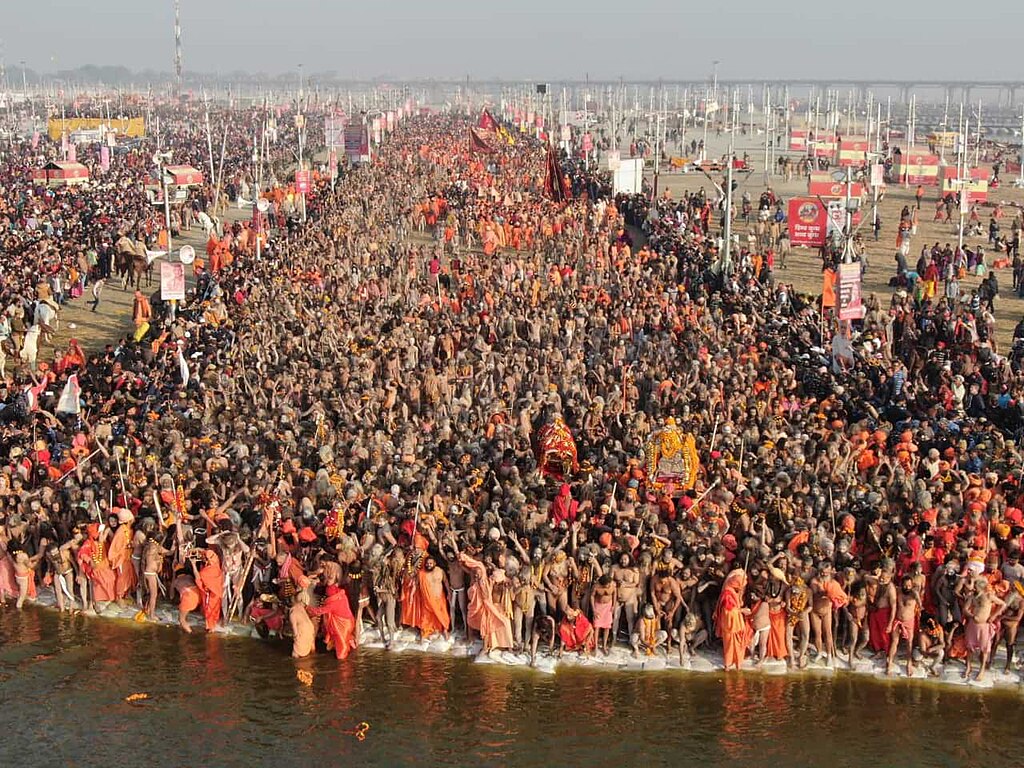Experts attribute the contamination to multiple factors, including untreated sewage discharge, open defecation, and the massive influx of pilgrims taking ritualistic baths.
Published Feb 18, 2025 | 2:53 PM ⚊ Updated Feb 18, 2025 | 2:53 PM

Devotees taking a dip on 17 January 2025. (RP Saroj/Creative Commons)
Synopsis: Contrary to a Union minister’s claim that technology contributed by nuclear centres is keeping the river waters clean, the Central Pollution Control Board has found high levels of human and animal excreta in Ganga and Yamuna, while millions of devotees take baths as part of the Kumbh ritual in Prayagraj. Experts are worried about possible diseases caused by the contaminated water.
The Central Pollution Control Board (CPCB) has found high levels of faecal and total coliform (human and animal excreta) in the Ganga and Yamuna rivers in Uttar Pradesh’s Prayagraj.
The findings amidst the ongoing Magh and Kumbh melas indicated alarmingly high levels of faecal and total coliform at multiple locations, making the water unfit for bathing and raising serious public health concerns for the millions of devotees participating in the religious festival.
The issue was brought to light during a hearing before the National Green Tribunal (NGT), where the CPCB presented its latest monitoring data.
The report said the levels of faecal coliform—a key indicator of microbial contamination—were far above the permissible limits.
On 13 January 2025, fecal coliform concentrations at Shringverpur Ghat reached 23,000 MPN/100ml, while at Deeha Ghat, they were recorded at 33,000 MPN/100ml.
A week later, on 20 January, the total coliform count at the sacred Sangam area surged to 700,000 MPN/100ml, highlighting the extent of pollution in the river.
Experts attribute the contamination to multiple factors, including untreated sewage discharge, open defecation, and the massive influx of pilgrims taking ritual baths.
The CPCB report also pointed out that despite the presence of 10 sewage treatment plants (STPs) in Prayagraj, one of them—Ponghat STP with a capacity of 10 MLD—failed to meet environmental norms, potentially contributing to the worsening water quality.
Adding to the regulatory failures, the Uttar Pradesh Pollution Control Board (UPPCB) came under scrutiny for its incomplete submission to the NGT.
Although the board provided water quality test reports, it failed to present a comprehensive action plan addressing the crisis. This led the tribunal to summon UPPCB officials to appear virtually on Wednesday, 19 February, to explain their inaction.
With millions of devotees continuing to gather for the Kumbh Mela, the deteriorating water quality raises concerns about the spread of waterborne diseases.
Environmental activists and public health experts have urged the authorities to take immediate steps to curb pollution and ensure safer conditions for pilgrims.
The NGT has directed CPCB and UPPCB to intensify monitoring efforts, increase sewage treatment efficiency, and prevent untreated waste from flowing into the rivers.
As the festival progresses, all eyes will be on the regulatory agencies to see whether they can implement urgent measures to protect the waters of the Ganga and Yamuna or if the concerns of contamination will continue to cast a shadow over one of the largest religious gatherings in the world.
Fecal coliform and total coliform are types of bacteria commonly used as indicators of water contamination, particularly from human and animal waste. Their presence in water suggests possible sewage pollution and raises concerns about the risk of disease-causing pathogens.
Total coliform is a broad group of bacteria found in soil, vegetation, and surface water. While some coliform bacteria are naturally present in the environment and are not harmful, their detection in drinking or bathing water can indicate contamination and the need for further testing.
Faecal coliform is a specific subgroup of total coliform bacteria that originates from human and animal feces. When found in water, it strongly suggests contamination from sewage or animal waste. One of the most common fecal coliform bacteria is Escherichia coli (E. coli), some strains of which can cause serious illnesses.
The presence of high levels of fecal coliform in water is a major concern because it indicates that the water may be contaminated with harmful microorganisms, including viruses, bacteria, and parasites. These pathogens can cause diseases such as diarrhea, typhoid, cholera, and hepatitis.
During large religious gatherings like the Kumbh Mela, where millions of devotees take ritual baths in the river, excessive coliform levels pose a significant public health risk.
To ensure water safety, regulatory agencies such as the Central Pollution Control Board (CPCB) and the Uttar Pradesh Pollution Control Board (UPPCB) regularly monitor these bacteria. Their assessments help in determining whether the water is safe for bathing and other activities.
Incidentally, Union Minister for Science and Technology Jitendra Singh has told reporters in Prayagraj that not even a single case of skin disease or other illness has been reported from the Kumbh Mela. He said more than 50 million devotees had so far attended the mela that would end on 26 February.
Singh said technology contributed by India’s nuclear research centres maintained the hygiene of the river waters. The Bhabha Atomic Research Centre in Mumbai and the Indira Gandhi Centre for Atomic Research in Kalpakkam have set up wastewater filtration plants in Prayagraj.
(Edited by Majnu Babu).
